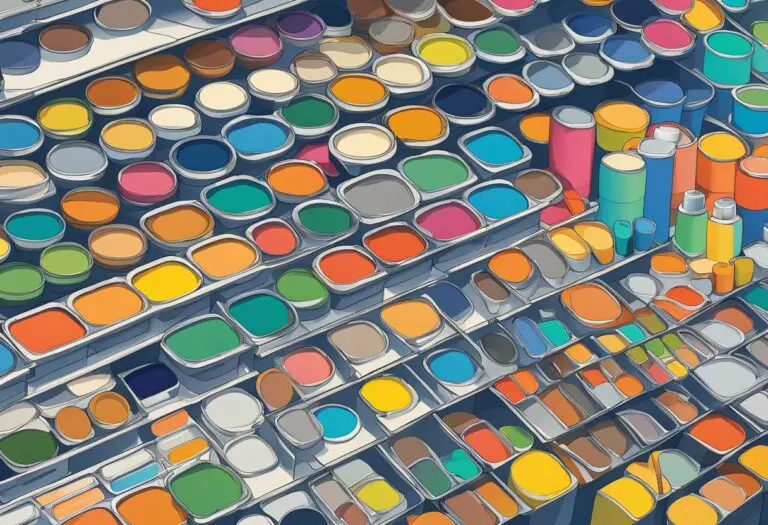Understanding Painting Canvas Types
Choosing the right canvas is crucial for any artist seeking to create remarkable oil or acrylic paintings. The type of canvas used can greatly impact the final result, from the texture and durability to the application of paint. In this article, we will explore the diverse world of painting canvas types, guiding you towards the best canvas for your artistic masterpieces.
Types of Artist Canvas Materials
When it comes to choosing the perfect canvas for your artwork, understanding the different types of artist canvas materials is essential. Each material offers unique characteristics and benefits that can greatly impact the final result of your masterpiece. In this section, we will explore three popular options: traditional cotton canvas, linen canvas, and polyester canvas.
Traditional Cotton Canvas
Cotton canvas has been a go-to choice for artists for centuries. It is affordable, widely available, and suitable for various painting techniques. The natural fibers of cotton provide a smooth and receptive surface for both oil and acrylic paints. Cotton canvas is also lightweight and easy to stretch, making it ideal for artists who prefer to create their own custom-sized canvases.
“Cotton canvas offers a versatile and cost-effective option for artists of all skill levels.” – Jane Smith, Professional Artist
Linen Canvas
Linen canvas is known for its exceptional durability and superior texture. Made from flax plant fibers, linen is highly regarded by professional artists for its strength and longevity. The surface of linen canvas has a slightly rough texture, which adds visual interest and depth to paintings. This material is particularly favored by oil painters due to its ability to withstand the heavy application of paint and the natural flexibility it offers.
“Linen canvas provides a luxurious and sturdy surface for oil painters, ensuring their artwork remains intact for years to come.” – Mark Johnson, Contemporary Artist
Polyester Canvas
In recent years, polyester canvas has gained popularity among artists looking for a more affordable and synthetic alternative. Polyester offers excellent resistance to moisture and humidity, making it a suitable choice for artists working in humid environments or using water-based paints. While it may lack the organic texture of natural fibers, polyester canvas provides a smooth surface that is ideal for fine details and precise brushwork.
“Polyester canvas offers a modern and cost-effective option for artists seeking durability and versatility.” – Lisa Chen, Mixed Media Artist
By understanding the characteristics and benefits of each artist canvas material, you can choose the one that best suits your artistic style, preference, and budget. Whether you opt for the traditional feel of cotton, the durability of linen, or the versatility of polyester, selecting the right canvas material is a crucial step in creating artwork that truly reflects your vision.
Canvas Texture Options

When it comes to painting canvases, the texture plays a vital role in the overall look and feel of a masterpiece. The choice of canvas texture can enhance details, add depth, and contribute to the overall artistic effect of a painting. Artists have a range of options to choose from, each offering a unique tactile experience and visual outcome.
One popular texture option is smooth canvas. This type of canvas has a fine texture, allowing artists to achieve precise and intricate details in their artwork. Smooth canvas is excellent for realistic paintings or pieces that require meticulous attention to detail. Artists who prefer working with a smooth surface can truly bring their vision to life with this texture option.
On the other hand, rough canvas provides a more textured surface that adds visual interest and depth to a painting. This texture option creates a rougher, uneven surface that can beautifully capture and reflect light. Artists often use rough canvas to create expressive and textured brushstrokes, imparting a sense of movement and energy to their artwork.
“The texture of canvas adds an extra dimension to a painting, enhancing the visual experience and bringing the artwork to life.” – Renowned artist, Mary Thompson
The choice of canvas texture depends on personal artistic preferences and the desired effect of the painting. Some artists may prefer the smooth texture for delicate and detailed work, while others may opt for rough canvas to create a more expressive and textured painting. Experimenting with different textures can lead to unique artistic styles and techniques.
Ultimately, selecting the right canvas texture is an essential decision for any artist. It is important to consider the subject matter, style, and intended effect of the artwork. By understanding the impact of canvas texture options, artists can elevate their work and bring their creative vision to life.
Best Canvas for Oil Painting
When it comes to oil painting, selecting the right canvas is crucial for achieving stunning results. The unique properties of oil paint, such as its thickness and slow drying time, require a canvas that can withstand these characteristics without deteriorating or affecting the final artwork. In this section, we explore the best canvas options for oil painting, providing guidance on choosing the most suitable canvas surface.
1. Primed Canvas
Primed canvas, also known as pre-primed or gessoed canvas, is a popular choice among oil painters. It is coated with a layer of primer made from a mixture of glue, chalk, and white pigment. This surface provides a smooth and even texture, perfect for capturing fine details and brushstrokes in oil paintings. Primed canvas also prevents oil from seeping into the fabric, ensuring the longevity of the artwork.
2. Unprimed Canvas
For artists looking for more control over the preparation process, unprimed canvas offers a versatile option. Unprimed canvas is essentially raw fabric without any coating or primer layers. Artists can apply their preferred primer, such as acrylic gesso or oil-based primer, to customize the surface according to their artistic needs. Unprimed canvas provides a unique texture and absorbency that allows for different painting techniques and effects.
3. Pre-stretched Canvas
If convenience and ready-to-paint surfaces are priorities, pre-stretched canvases are an excellent choice. These canvases come already stretched onto wooden frames, eliminating the need for additional stretching or framing. They are available in various sizes and dimensions, ensuring artists can find the perfect fit for their artistic vision. Pre-stretched canvases are often primed, offering a smooth surface suitable for oil painting.
Now that we have explored the best canvas options for oil painting, it is important to consider the specific needs and preferences of the artist. Each canvas type offers unique benefits and possibilities for creating beautiful oil masterpieces. Whether opting for primed canvas, unprimed canvas, or pre-stretched canvas, artists can confidently choose a canvas surface that aligns with their creative process and desired outcomes.
| Canvas Type | Features |
|---|---|
| Primed Canvas | – Coated with a layer of primer |
| Unprimed Canvas | – Raw fabric without any coating |
| Pre-stretched Canvas | – Ready-to-paint surfaces |
Best Canvas for Acrylic Painting
When it comes to acrylic painting, selecting the right canvas is crucial to ensure optimal results. Acrylic paint is known for its fast-drying nature, requiring a supportive and non-absorbent surface that allows for easy application and vibrant colors. Here, we explore the best canvas options for acrylic painting, guiding you towards achieving your artistic vision.
Acrylic-Primed Canvas
Acrylic-primed canvas is specifically designed to enhance the performance of acrylic paints. Its surface is coated with a layer of acrylic primer, which creates a barrier between the canvas fabric and the paint. This prevents the paint from soaking into the canvas and provides a smooth and stable surface for brushstrokes. Acrylic-primed canvas is versatile and suitable for both beginners and professional artists.
Gessoed Canvas Boards
Gessoed canvas boards offer a compact and convenient option for acrylic painters. These boards are made by mounting a canvas fabric onto a rigid surface, such as wood or cardboard, and then applying multiple layers of gesso. The gesso provides a sturdy and non-absorbent surface that is perfect for acrylic paint. Canvas boards are lightweight and can be easily framed or displayed without the need for stretching.
Other Acrylic-Specific Surfaces
In addition to traditional canvas options, there are other surfaces specifically designed for acrylic painting. These include acrylic paper, which is a heavyweight paper treated with an acrylic-friendly surface, and acrylic panels, which are rigid panels coated with an acrylic-friendly surface. These alternatives provide different textures and finishes, allowing artists to experiment and achieve unique effects with their acrylic paintings.
Tips for Preparing the Canvas
Before starting an acrylic painting, it is essential to properly prepare the canvas. This ensures that the paint adheres well and allows for smooth brush application. Here are some tips for preparing your canvas:
- Ensure the canvas is clean and free from dust or debris.
- Apply a thin layer of acrylic gesso to prime the canvas, creating a smooth and stable surface.
- Allow the gesso to dry completely before starting the painting process.
- Sand the surface lightly with fine-grit sandpaper to achieve an even texture, if desired.
By following these preparation steps, you will set a solid foundation for your acrylic painting and achieve the best possible results.
Remember, the choice of canvas plays a significant role in the outcome of your acrylic masterpiece. Consider the specific needs of acrylic paint and experiment with different surfaces to discover the one that best suits your artistic style and preferences.
Conclusion
After exploring the diverse world of painting canvas types, it is clear that choosing the right canvas for your artistic endeavors is crucial. By considering different canvas materials, texture options, and the specific needs of your chosen medium, you can enhance your painting experience and achieve the desired results.
When it comes to canvas materials, traditional cotton, durable linen, and synthetic options like polyester offer unique characteristics and benefits. Each material caters to different artistic preferences and techniques.
Additionally, the texture of your canvas plays a vital role in the overall look and feel of your artwork. Selecting a smooth canvas for precise details or a rough canvas for added texture and depth is a decision that can profoundly impact your creative expression.
Remember, whether you’re an oil painting enthusiast or prefer working with acrylics, understanding the best canvas choices for your chosen medium is crucial. By considering painting canvas types and texture options, you can make informed decisions and lay the foundation for your artistic success. Choose the canvas that best suits your style, and let your creativity flourish on the perfect surface.







